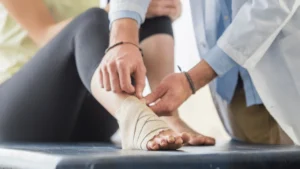Overview
Ankle injuries are among the most common injuries experienced by both athletes and non-athletes alike. The ankle joint is made up of several ligaments, tendons, and bones that work together to provide stability and mobility. However, due to its complexity and the constant pressure it endures, the ankle is prone to various types of injuries. Understanding the types of ankle injuries and their recovery strategies can help individuals prevent further damage and promote a faster healing process.

Symptoms and Causes
The symptoms of ankle injuries vary depending on the specific type of injury. However, common symptoms include pain, swelling, difficulty bearing weight, and limited range of motion. Ankle injuries can be caused by a wide range of factors, including sports-related activities, accidents, improper footwear, and chronic conditions such as arthritis. Sprains, strains, fractures, and Achilles tendonitis are some of the most common ankle injuries individuals may experience.
Diagnosis and Tests
When it comes to diagnosing ankle injuries, healthcare professionals typically conduct a thorough physical examination and may order additional tests. X-rays can help detect fractures or dislocations, while MRI or CT scans can provide a more detailed view of the soft tissues and ligaments. If there is suspicion of ligament damage, the healthcare provider may perform a stress test or an ultrasound to assess the extent of the injury and determine the most appropriate treatment plan.
Management and Treatment
Managing and treating ankle injuries is crucial for a successful recovery. Initially, the RICE method (Rest, Ice, Compression, Elevation) is often recommended, along with over-the-counter pain medication to reduce pain and swelling. Depending on the severity of the injury, healthcare professionals may suggest immobilization through the use of braces, splints, or casts. Physical therapy exercises are commonly prescribed to improve strength, flexibility, and balance. In more severe cases, surgery may be required to repair damaged ligaments or fractures.
Prevention
Preventing ankle injuries involves adopting various preventive measures. Wearing appropriate footwear that provides adequate support and cushioning is vital, especially during physical activities. Regular stretching, especially targeting the ankle area, can improve flexibility and reduce the risk of injury. Maintaining a healthy weight can also help prevent unnecessary stress on the ankle joints. It is important to be mindful of one’s surroundings and avoid tripping hazards, be cautious during sports activities, and gradually increase exercise intensity to avoid overexertion.
Outlook / Prognosis
The outlook for ankle injuries largely depends on the type and severity of the injury, as well as the individual’s adherence to the prescribed treatment plan. With proper management and care, most ankle injuries can heal within a few weeks to several months. However, in some cases, chronic pain or instability may persist, requiring long-term management. It is crucial to follow healthcare providers’ instructions, attend follow-up appointments, and seek prompt medical attention if symptoms worsen or new complications arise.
Frequently Asked Questions
1. How long does it take for an ankle injury to heal?
The healing time for ankle injuries can vary greatly depending on the type and severity of the injury. Mild sprains may heal within a few weeks, while more severe fractures may require several months of rehabilitation.
2. Can I exercise with an ankle injury?
It is important to consult with a healthcare professional before engaging in any exercise with an ankle injury. Depending on the specific injury, certain exercises may be beneficial for recovery, while others may worsen the condition. Proper guidance from a healthcare professional can ensure a safe and effective exercise plan.
3. Are ankle injuries more common in athletes?
While ankle injuries are indeed common among athletes, they can occur in anyone. Everyday activities, such as walking on uneven surfaces or wearing ill-fitted shoes, can lead to ankle injuries. However, athletes may be more prone to ankle injuries due to the high-impact nature of sports and the repetitive stresses placed on the ankle joints.
4. Can ankle injuries be prevented?
While it is impossible to prevent all ankle injuries, adopting preventive measures can significantly reduce the risk. Wearing appropriate footwear, engaging in regular stretching and warm-up exercises, and being cautious during physical activities are some of the key strategies for ankle injury prevention.
Conclusion
Ankle injuries can be debilitating, causing pain, immobility, and a decreased quality of life. Understanding the different types of ankle injuries and implementing appropriate recovery strategies is essential for effective treatment and prevention. By following recommended management and treatment plans, individuals can ensure a faster and more successful recovery, allowing them to resume their regular activities and minimize the chances of recurrent ankle injuries in the future.